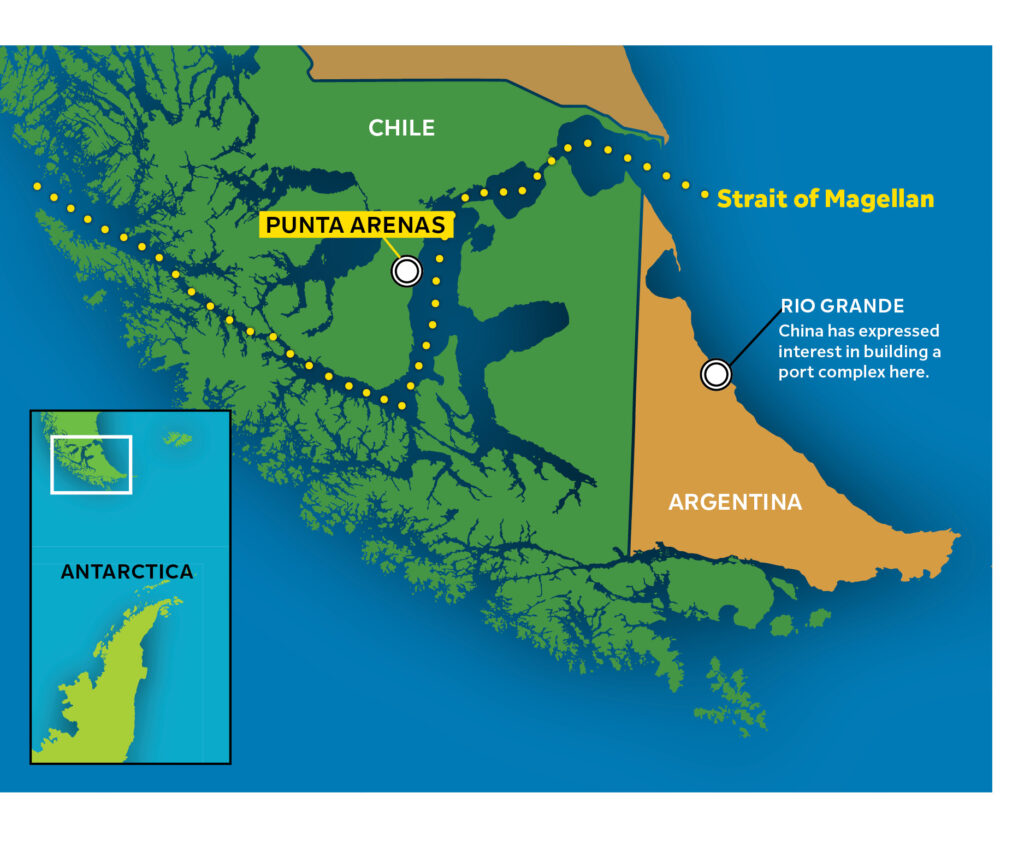From Americas Quarterly, April 23:
Punta Arenas sits at the very tip of South America…Punta Arenas is at the intersection of changing shipping routes, new industries like green hydrogen, and the race for Antarctica. The U.S. and China have noticed.
This article is adapted from AQ’s special report on Latin America’s ports | Leer en español | Ler em português
PUNTA ARENAS, CHILE — Perched on the pylons of a century-old coal pier, sleek black cormorants gaze out at cruise ships, propane tankers and research vessels dotting the white-capped Strait of Magellan. Farther into the horizon, a humpback whale blows a misty plume toward the sky.
This is a postcard from the end of the world, postmarked Punta Arenas.
But it’s not as remote as you might think.
Punta Arenas has become an unlikely hotspot for global shipping, one of several seaports gaining importance today across Latin America and the Caribbean. As wars choke vital shipping lanes in the Middle East and Europe, climate change snarls the Panama Canal and technological breakthroughs such as green hydrogen come to the fore, even ports on the region’s periphery are getting new attention from governments, multinational companies and others.
The changing tide is reflected in the soaring volume of merchant ships crossing the Strait of Magellan. In January and February, traffic jumped by 25% from the same period in 2023, and by 83% compared with 2021, when supply chains were still disrupted by the pandemic. Chile’s navy is bracing for this year’s traffic to increase by as much as an additional 70%.

“We’re in a part of the world that’s increasingly strategic, and it transcends the country,” Punta Arenas Mayor Claudio Radonich told AQ.
Global powers are racing to expand their presence. China has expressed interest in building a port complex near the Strait’s Atlantic mouth just across Chile’s border in Argentina. From there, Beijing could grow its presence in the region and also project influence in Antarctica, where geopolitical rivalry is heating up as the sea ice melts. In April 2023, the head of the U.S. military’s Southern Command, General Laura Richardson, visited Argentina and Chile, stopping in Punta Arenas for a security briefing and a tour of the strait.
when we were a free port and ship traffic was enormous.”
—María José Navajas, regional director of Corfo
To properly seize the moment, Punta Arenas and the surrounding Magallanes region desperately need an infrastructure upgrade. At present, the region only has a few jetties and ramps, capable of receiving midsize vessels, some cruise ships and barges—but not large tankers and container vessels of the kind increasingly sailing through the strait. There are no loading cranes or protected basins. Even the navy lacks a port of its own here.
“If we want to move toward more just and inclusive development, we need more and better ports,” Chile’s President Gabriel Boric declared last October at the signing of a port expansion plan in Valparaíso. He lauded the “extraordinary modernization” of ports he had visited in China the previous week. Boric, who grew up in Punta Arenas, signed a $400 million, five-year investment program in November to upgrade ports and other infrastructure in Magallanes. But some wonder if it will be enough....
....MUCH MORE